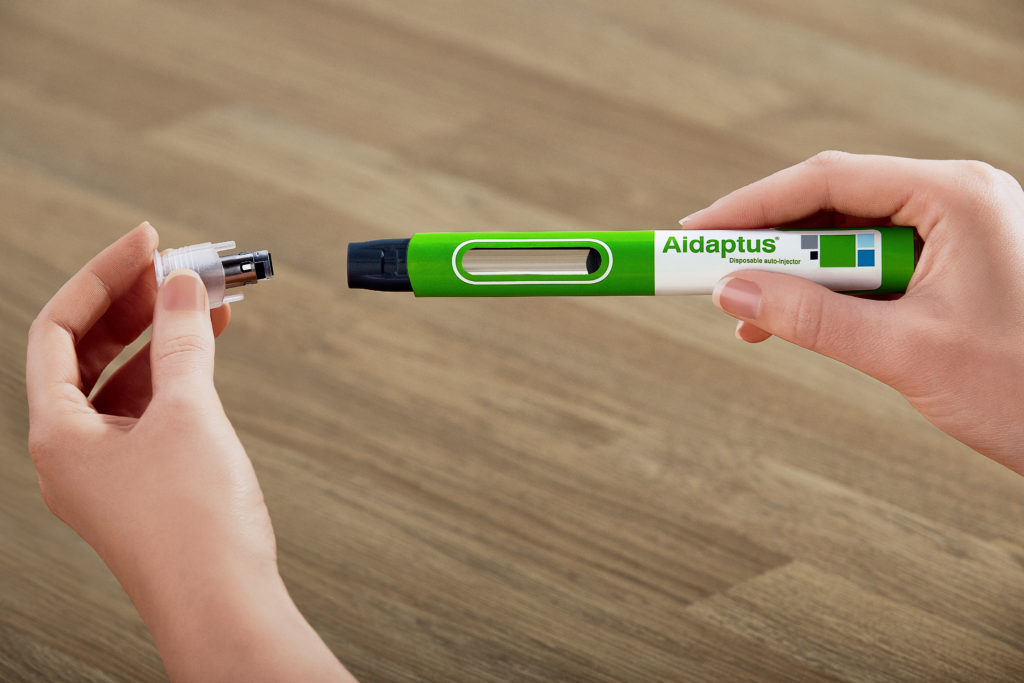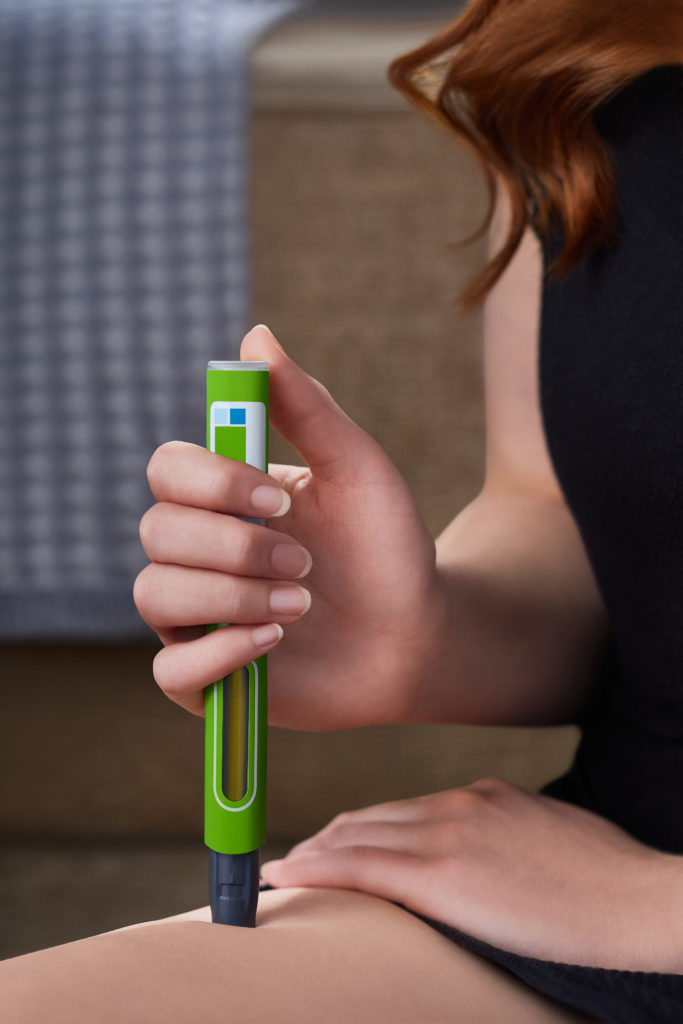To Issue 133
Citation: Earl M, “A Checklist for Autoinjector Design”. ONdrugDelivery, Issue 133 (May 2022), pp 76–78.
Michael Earl outlines the five key questions autoinjector designers typically ask during the development process and the choices available for tailoring autoinjector products.
“The design of drug delivery devices has developed to accommodate a variety of needs and patient requirements over the years.”
In 2021, the global subcutaneous drug delivery devices market was estimated to be worth US$25.53 billion (£19.46 billion) and is expected to grow to more than $56.9 billion by 2030 – a compound annual growth rate of 9.3%.1 This market includes devices such as prefilled syringes (PFSs), reusable and disposable pen injectors and autoinjectors. Pharmaceutical companies are increasingly moving from syringes and vials to drug delivery devices, simplifying the drug delivery process for the patient and providing more convenience with PFSs and autoinjectors.
As well as the benefits for patients, healthcare systems may see reduced pressure if more intravenous drugs – typically administered in acute care – can be reformulated for subcutaneous preparations. A notable example is the development of Neulasta (pegfilgratim) in a formulation for subcutaneous delivery. This allows cancer patients to administer their own medication outside of acute care, rather than prolong their hospital stay or return to the clinic.
Given increased demand and evolving requirements for subcutaneous administration, the design of drug delivery devices has developed to accommodate a variety of needs and patient requirements over the years. As a designer and manufacturer of these devices, Owen Mumford Pharmaceutical Services has developed a range of technologies and solutions over the past decades to help address common challenges.
HOW WILL THE SPRING BE POSITIONED?
Compression springs are critical to the function of most autoinjectors (Figure 1). They create the “powerpack” to both insert the needle and move the plunger to deliver the drug into the patient. These springs can be positioned in a variety of ways within the autoinjector, with a rearward position being the most common design. Springs can be either external or internal to the primary container. An external spring helps to deliver variable-volume doses and more viscous drugs but creates a larger-diameter device than those with an internal spring. Constant-force springs provide flexibility in the delivery force curve and are more commonly used in reusable autoinjectors.

Figure 1: Compression springs are critical to the function of most autoinjectors.
“With multiple regulations on the prevention of needlestick injuries globally, drug delivery devices must protect patients and carers from sharps injuries when injecting.”
HOW WILL THE PATIENT ACTIVATE THE INJECTION PROCESS?
Patients can either manually insert the needle and deliver their medication or activate the injection via a button on the top or side of the autoinjector. Alternatively, the device can be automatically activated once the patient presses the autoinjector onto the selected injection site – removing a user step in the process. Once injection is activated, needle insertion and dose delivery are typically achieved in a single phase controlled by the release of a single spring. Single-phase delivery provides a consistent administration sequence for the patient and makes for a less complex device with fewer components.
The new disposable autoinjector platform Aidaptus® from Owen Mumford Pharmaceutical Services employs two-phase drug delivery (Figure 2). Needle insertion and plunger depression for dose administration are two separate, independent phases, each controlled by an individual spring with the appropriately designed force. This can help to prevent the syringe breaking, a problem that can occur when using only a single strong spring. It can also help to prevent drug spillage before injection, since the needle must be inserted before the drug is delivered.

Figure 2: The new disposable autoinjector platform Aidaptus® from Owen Mumford.
An additional safety feature of autoinjectors is the locking and prevention of pre-activation – restricting the patient from initiating the injection and exposing the needle too early. To achieve this, some devices employ an interlock design on the cap to keep it securely in place prior to removal. An alternative safety interlock can be employed between the front and rear body of the device so that injection cannot occur until the patient depresses the safety shroud on the injection site, engaging the two sections.
“A patient-centric approach to product design should incorporate the aim of encouraging and improving medication adherence.”
HOW WILL USERS BE PROTECTED FROM INJURY?
With multiple regulations on the prevention of needlestick injuries globally, drug delivery devices must protect patients and carers from sharps injuries when injecting. There are two main options: the needle can automatically retract safely into the autoinjector following injection or the needle can be protected using a shroud that is deployed following administration. The first option results in a less-complex device with a lower component count, helping to simplify the manufacturing process; however, patients may need training to ensure that devices using this method are being used correctly.

Figure 3: Aidaptus® has a self-adjusting plunger to accommodate multiple fill volumes.
CAN THE DEVICE ACCOMMODATE DIFFERENT FILL VOLUMES?
The maximum volume for single delivery via subcutaneous administration is typically less than 3 mL. More recent studies have shown higher volumes may be possible, especially if administered over a longer period of time.2 The number of devices that can accommodate 2.25 mL PFSs has grown in recent years. Additionally, the industry has seen the introduction of wearable drug delivery devices specifically designed to deliver larger volumes above 3 mL. Conversely, the protein nature of biologics means that doses for these drugs are often less than 1 mL and require accurate dosing and delivery.
Fill-volume flexibility in a single autoinjector allows pharmaceutical companies to keep the same device if formulation changes are made in early drug development, through clinical trials or even later on in lifecycle management. One approach for enabling different doses in one device is to select a variable-dose autoinjector with a single-use PFS. This allows for volume variations such as weight-based dosing. However, some of the drug may potentially be wasted with this option.
Aidaptus takes a novel approach. The autoinjector has a self-adjusting plunger to accommodate multiple fill volumes – with no change parts in the device (Figure 3). The plunger is also automatically positioned to allow limited rearward movement of the stopper, without impacting container closure integrity. This is critical to maintaining sterility of the contents of the primary container in transport and storage as it travels from factory to patient.
DISPOSABLE OR REUSABLE?
The first autoinjector to come to market – the Autoject® 1 designed and produced by Owen Mumford – was designed for reuse and also featured automatic needle insertion. Since then, single-use, disposable autoinjectors have dominated the market, driven by convenience and ease of use. The annual volume of these products is currently estimated to be above 100 million.3 Today, options for reusable autoinjectors are being seriously reviewed as the pharmaceutical industry and its suppliers increase their sustainability efforts to help meet national and international targets.
A potentially conflicting trend is the desire for more digitally connected devices to transfer key data. Adding electronics to drug delivery devices makes recycling and reuse more complex – and introduces regulatory obligations, such as compliance with the European directive on Waste Electrical and Electronic Equipment (WEEE). One solution is to add electronics to a reusable device or a reusable unit that is separate to the disposable autoinjector. Another simple option is to customise labels or wraps on the autoinjector to add radio frequency identification (RFID) tags for connectivity.
GROWTH AND INNOVATION
Autoinjectors have been in common use since the mid-1980s. Many patients have learnt to make them a part of their daily routine to treat chronic conditions. New designs of these devices offer multiple options for drug delivery, while improving ease of use for the patient. A patient-centric approach to product design should also incorporate the aim of encouraging and improving medication adherence. This is critical as healthcare demand and associated costs continue to increase, driven in part by the ageing population and a resulting rise in chronic diseases. This growing need, coupled with a growing market and advances in technology, mean that autoinjectors in a variety of designs will continue to play a key role in medication administration for years to come.
REFERENCES
- “Subcutaneous Drug Delivery Devices Market (By Product Type: Auto-Injectors, Pen Injectors, Prefilled Syringes, Wearable Injectors, and Needle-Free Injectors; By Distribution Channel: Retail Pharmacies, Hospital Pharmacies, and Online Pharmacies) – Global Industry Analysis, Size, Share, Growth, Trends, Regional Outlook, and Forecast 2021–2030”. Precedence Research.
- Badkar AV et al, “Subcutaneous Delivery of High-Dose/Volume Biologics: Current Status and Prospect for Future Advancements”. Drug Des Devel Ther, 2021, Vol 2021(15), pp 159–170.
- Owen Mumford internal analysis based on multiple sources.

